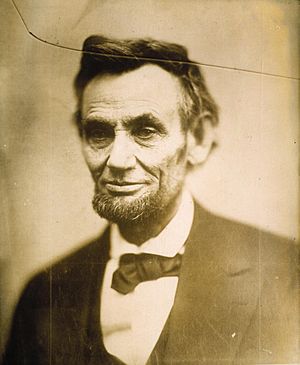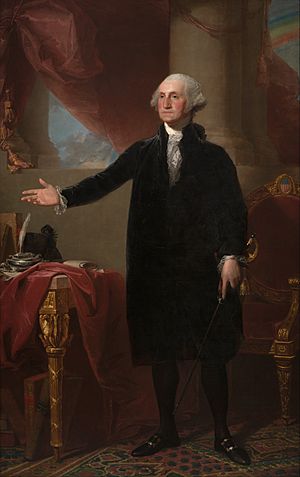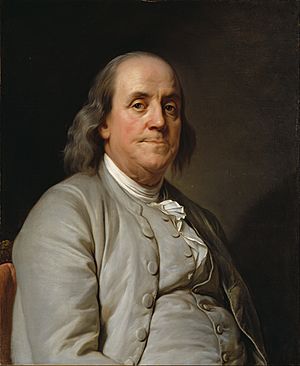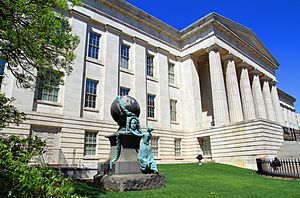National Portrait Gallery (United States) facts for kids
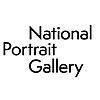 |
|
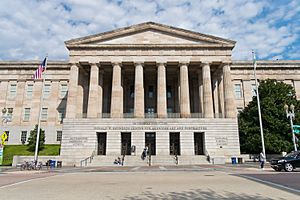
National Portrait Gallery's F Street entrance
|
|
| Established | 1962 |
|---|---|
| Location | Eighth and F Streets, NW, Washington, D.C., U.S. |
| Visitors | 1,069,932 |
| Public transit access | |
The National Portrait Gallery (NPG) is a famous art museum in Washington, D.C., USA. It opened in 1968 and is part of the Smithsonian Institution. This museum collects and shows pictures of important Americans. It shares a historic building with the Smithsonian American Art Museum. This building is called the Old Patent Office Building.
History of the Museum
How the Museum Started
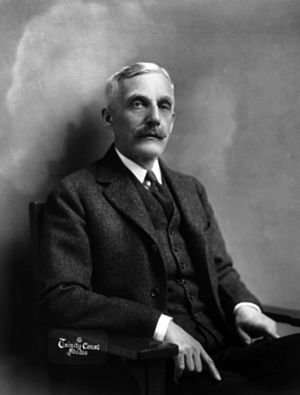
The idea for a national portrait gallery in the U.S. began a long time ago. In 1796, Charles Willson Peale opened an early portrait gallery. Later, in 1886, a man named Robert C. Winthrope visited the National Portrait Gallery in London. He then pushed for a similar museum in the United States.
In 1919, the Smithsonian Institution helped create a National Art Committee. This group wanted to get portraits of famous leaders from World War I. These portraits became the first part of what would become the National Portrait Gallery's collection.
In 1937, Andrew Mellon gave his large art collection to the United States. This led to the creation of the National Gallery of Art. Mellon's gift included many portraits. He asked that these portraits be moved to a new gallery if one was ever created.
In 1957, there was a plan to tear down the Old Patent Office Building. But people wanted to save this historic place. So, in 1958, Congress allowed the Smithsonian to use it as a museum. A committee was then formed to plan for a national portrait museum in this building.
The National Portrait Gallery (NPG) was officially created by Congress in 1962. Its goal was to show portraits of "men and women who have made important contributions to the history, growth, and culture of the United States." At first, the museum could only collect paintings, prints, drawings, and engravings. It was hard to find art for the new museum. Smithsonian Secretary S. Dillon Ripley encouraged curators to find unique pieces. The NPG slowly built its collection through gifts and purchases.
The first NPG exhibit opened in 1965. The museum moved into the Old Patent Office Building in 1966. It opened to the public on October 7, 1968.
Growing the Collection
The Old Patent Office Building was updated in 1969. In 1973, the NPG held its first exhibit focused only on African Americans. In 1974, Paul Mellon gave the museum 761 portraits by a French-American artist named C.B.J.F. de Saint-Mémin.
In 1976, Congress allowed the NPG to collect photographs. This was a big change! The NPG quickly grew its photo collection. In 1978, its first photo exhibit opened. The museum also bought other important artworks. In 1977, it got a self-portrait by Mary Cassatt. In 1978, it got a self-portrait by John Singleton Copley.
In 1978, Time magazine gave the museum 850 original portraits. These had been used on its covers between 1928 and 1978. A large exhibit of these portraits opened in 1979.
More Famous Portraits Added
The National Portrait Gallery kept adding to its collection. In 1979, it got five more portraits by Gilbert Stuart. These included paintings of presidents George Washington, Thomas Jefferson, James Monroe, John Adams, and James Madison. The Coolidge family of Boston donated them. The museum also got a bust of Alexander Hamilton and a portrait of Fisher Ames. In 1980, the museum received portraits of Jefferson Davis and his wife, Varina Howell Davis.
By 1981, the museum had over 2,000 items. It added two large collections of 19th-century photographs. One was the Frederick Hill Meserve Collection. It had 5,419 glass negatives from the studio of Mathew Brady, a famous Civil War photographer. Later that year, 5,400 Civil War-era glass negatives by Alexander Gardner were also bought. This included the famous "cracked-plate" portrait of Abraham Lincoln. This was the last photo of Lincoln taken before he died in 1865.
The museum also bought two important portraits. One was a Gilbert Stuart portrait of Thomas Jefferson for $1 million. The other was an Edgar Degas portrait of Mary Cassatt for $1.3 million.
In 1984, some important handwritten documents were stolen from the museum. These included papers signed by President Abraham Lincoln and Civil War generals. The FBI helped find them. All four documents were recovered safely.
In the late 1980s, the collection grew more. In 1985, the museum got its first nude artwork. It was a self-portrait by Alice Neel, who was 80 years old. In 1987, photographer Irving Penn gave 120 platinum prints of fashion and celebrity portraits.
In the 1990s, two very important daguerreotypes (early photos) were bought. One was of Frederick Douglass, an African American abolitionist and former slave. The other was the earliest known daguerreotype of John Brown, a famous abolitionist. This photo was taken by African American photographer Augustus Washington.
Buying the Lansdowne Portrait
In 2000, a very important painting, the Lansdowne portrait of George Washington, was offered for sale. This large painting was made by Gilbert Stuart in 1796. It was a gift to the British Prime Minister. The painting had been on loan to the National Portrait Gallery for many years. The owner wanted to sell it for $20 million. The museum needed to find a donor quickly.
On March 13, 2001, the Donald W. Reynolds Foundation donated $30 million to buy the portrait. This generous gift also included money to send the portrait on a national tour. It also paid for a new area in the Old Patent Office Building to display it. The museum named this display area after Donald W. Reynolds.
After the Renovation
The National Portrait Gallery closed in January 2000 for a big renovation of the Old Patent Office Building. It was supposed to take two years and cost $42 million. But it ended up taking seven years and costing $283 million! During this time, most of the NPG's collection traveled around the United States.
The National Portrait Gallery reopened on July 1, 2006. The total cost of the renovation was $283 million. After the renovation, many more people visited the museum.
In 2008, after the presidential election, the National Portrait Gallery got Shepard Fairey's famous "Hope" poster of Barack Obama.
Recent Exhibits of Note
In 2012, the National Portrait Gallery held a special exhibit called "Poetic Likeness: Modern American Poets." This exhibit showed pictures of great American poets. The NPG's collection had grown so much that it used almost only its own artworks for this show.
Museum Collection
As of 2011, the National Portrait Gallery was the only museum in the U.S. focused only on portraits. In 2013, it had 65 employees and a $9 million yearly budget. By February 2013, it held 21,200 artworks. Over a million people visited in 2012.
How Portraits Are Chosen
The National Portrait Gallery has rules for which images join its collection. The person in the portrait must be historically important. Usually, a person needs to have been gone for at least 10 years before their portrait can be shown. However, portraits of very important living people, like presidents, can be added sooner.
Curators, who are art experts, discuss new artworks. They think about how many portraits of that person are already in the museum. They also consider the quality of the art, if it's unique, who made it, and its cost. The museum's board of directors then approves the final choices.
Key Exhibits and Programs
A special part of the National Portrait Gallery is the Hall of Presidents. It has portraits of almost all American presidents. It is the largest collection of presidential portraits outside the White House. The famous Lansdowne portrait of George Washington is a highlight here.
The museum now commissions (asks artists to create) portraits of presidents and First Ladies. These projects are paid for by private donations.
Some of the museum's most famous artworks include:
- "Abraham Lincoln" (cracked glass plate; 1865) by Alexander Gardner
- "Alexander Hamilton" (bust, 1789) by John Trumbull
- "Benjamin Franklin" (about 1785) by Joseph Duplessis
- "Charlie Chaplin" (1925) by Edward Steichen
- "Colin Powell" (2012) by Ron Sherr
- "Frederick Douglass" (daguerreotype, 1856) by an unknown artist
- "George Washington" (unfinished, 1796) by Gilbert Stuart
- "Hope" (Barack Obama) (2008) by Shepard Fairey
- "John Brown" (daguerreotype, 1846–1847) by Augustus Washington
- Lansdowne portrait (George Washington) (1796) by Gilbert Stuart
- "Mary Cassatt" (1880–1884) by Edgar Degas
- "Self-Portrait" (1880) by Mary Cassatt
- "Thomas Jefferson" (1805) by Gilbert Stuart
- "Barack Obama" (2018) by Kehinde Wiley
Some of the museum's important collections are:
- Alexander Gardner (photographs)
- Howard Chandler Christy (graphic art)
- Irving Penn (photographs)
- Mathew Brady (photographs)
- Time magazine covers (graphic art)
The Museum Building
The National Portrait Gallery is located in the Old Patent Office Building. This building is a National Historic Landmark. It was built between 1836 and 1867. It has a beautiful stone front and columns that look like the Parthenon in Greece.
During the American Civil War, the building was used as a hospital. Famous people like Clara Barton and Walt Whitman worked as nurses there. Over the years, other government offices used the building.
In the 1950s, some people wanted to tear down the building to build a parking garage. But many people, including architects and preservation groups, fought to save it. In 1958, Congress decided to give the building to the Smithsonian for a national art museum. President Dwight Eisenhower signed the law.
The National Portrait Gallery opened in the building in 1968 after renovations.
Renovation from 2000 to 2007
In 1995, the Smithsonian announced that the Old Patent Office Building needed major repairs. It closed in January 2000 for a big renovation. This project took seven years and cost $283 million.
During the renovation, a decision was made to add a glass roof over the open courtyard in the middle of the building. This was a big change! In 2004, architect Norman Foster was chosen to design the glass roof. Robert and Arlene Kogod donated $25 million for this project. Today, this area is called the Kogod Courtyard. It's a popular place to meet in Washington, D.C., with seating, free Wi-Fi, and a cafe.
The design for the glass roof had to be approved by several groups. This caused some delays. In 2005, the Donald W. Reynolds Foundation gave another $45 million to finish the renovation and the glass roof. Because of this large gift, the entire complex, including both museums and the courtyard, is now called the "Donald W. Reynolds Center for American Art and Portraiture." The National Portrait Gallery reopened on July 1, 2006.
After the reopening, many more people visited the museum.
Leaders of the Museum
The National Portrait Gallery is guided by a board of directors called the National Portrait Gallery Commission. The museum is led by a Director, who manages its daily activities.
Past Directors of the museum include:
- Charles Nagel – 1964–1969
- Marvin Sadik – 1969–1981
- Alan M. Fern – 1982–2000
- Marc Pachter – 2000–2007
- Martin E. Sullivan – 2008–2012
- Wendy Wick Reaves – 2012–2013 (interim)
- Kim Sajet – April 2013–present
|
See also
 In Spanish: Galería Nacional de Retratos (Washington) para niños
In Spanish: Galería Nacional de Retratos (Washington) para niños


